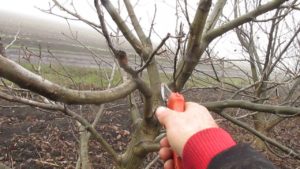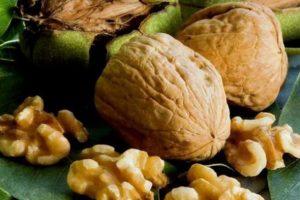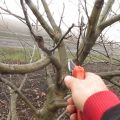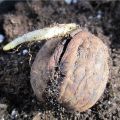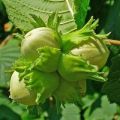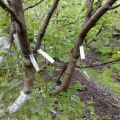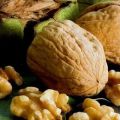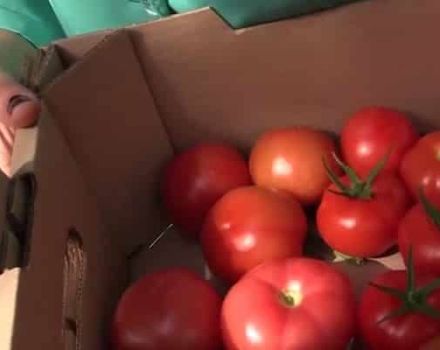Causes of diseases and pests of walnuts, treatment and control of them
One of the most popular crops that yields a valuable nut is difficult to grow. In addition to favorable conditions, walnuts need careful care in compliance with the rules of agricultural technology. In case of deviations from the rules, you will have to deal with walnut diseases, pest infestation. In this case, you can lose the harvest, as well as the unique tree.
Causes of diseases and pests
Many factors cause diseases of the nut crop. It is possible to determine what is happening to the tree by the state of the bark, leaves, fruits. When the leaves of a walnut turn black, this means that a serious infection has struck the plant. We must deal with it immediately. Pathogenic microorganisms retain their activity for a long time, waiting for suitable conditions for reproduction.
They attack those plants that are planted in the area where:
- little light;
- swampy soil due to the close occurrence of groundwater;
- the acidity of the soil is high;
- soils are poor in nutrients.
The nut, which is weakened by the winter cold, spring frosts, is attacked by fungi, bacteria, and also insect parasites. Such specimens of a walnut do not bear fruit, they are constantly sick.
What can pick up a walnut
Infectious diseases lie in wait for plants at every turn. If there are trees in the garden with tissues damaged by pathogenic bacteria, fungi, then neighbors are also infected from them. It is possible to determine the type of disease by certain signs. Then a systematic struggle should take place taking into account the specifics of the infection, the characteristics of its course.
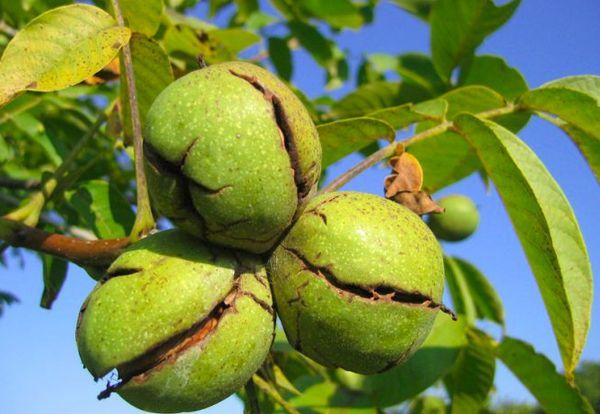
Bacteriosis
In the spring, when it is warm and damp, it is necessary to carefully examine the walnut trees. Awakened insects can transfer pollen with pathogenic bacteria from one plant to another. Bacteriosis is manifested by dark spots on leaves, fruits, shoots, flowers. The period of pollination of walnuts is especially dangerous because of the increased likelihood of infection through pollen.
The result of the action of bacteria will be a loss of yield, as flowers and ovaries will die. But even the young fetus is exposed to pathogens. Then it shrivels and falls off. And all parts of the plant become brown.
Bacterial burn
The rapid development of an infectious disease leads to the death of the tree. It's scary to look at a diseased plant. It seems that the crown, the trunk - everything is burnt. Black becomes dominant on the leaves.Young shoots stop developing and dry up. The kidneys die off. The inside of the fruit turns black. Ulcers on the entire aboveground part of the nut spread faster during periods of rain. It is very difficult to save the plant if the disease has taken on advanced forms.
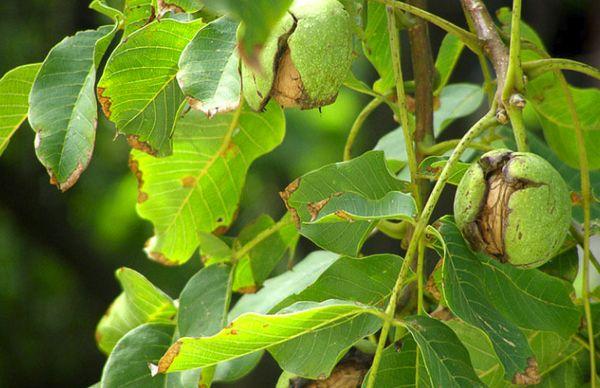
Brown spot (marsoniasis)
Marsonium fungus causes spotting on leaves, fruits of culture. First, in May, yellowness begins to appear on young leaves. Small specks grow, turn brown. When they merge, the leaf falls off. The ovaries are also covered with reddish brown dots. Nuts cannot be eaten internally, as the kernel deteriorates and dries. Half of the garden crop is affected by the effects of the infection.
Root cancer
Rod-shaped bacteria survive the winter in soil to begin multiplying in the spring. Through the penetration of bacteria into the roots of the walnut, the plant becomes infected. And the gates of infection are cracks, wounds on the surface of the root system. Under the action of bacteria on the tissues of the underground part of the nut, growths and sagging are formed.

You can notice the pathology by the delay in the growth of the walnut. Cancer is diagnosed by digging up a tree and examining its roots. Only timely medical measures will save the tree from death.
Nut pest insects
A weakened walnut is often the focus of garden pests. Insects try to lay eggs on leaves, bark, fruit. It is difficult to spot some of the parasites, so you need to know how the results of their life are reflected in the culture.
American white butterfly
A dangerous pest of the hazel plantation is a common butterfly with white wings, sometimes decorated with dark dots. By laying eggs on leaves and shoots, the female causes great damage to the tree. The greediness of the caterpillars that were born is great. They can destroy all foliage and young growth. Having passed to neighbors, the larvae of the parasite continue their activity. During the summer, the female makes 3 clutches of eggs, so the number of caterpillars only increases.
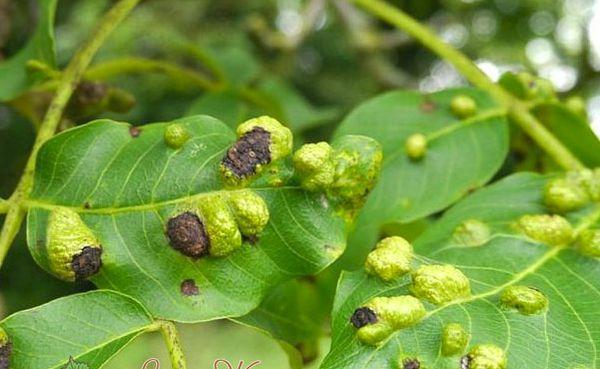
Sapwood
Weakened specimens of the nut crop are attacked by a black bug, the size of which ranges from 3-4 millimeters. It has a black head and brown elytra. Beetles fly intensively in June. It is difficult to see the beetle larvae as they hide under the bark.
If the wood is damaged, then the sapwood larvae make their way inside. There they, gnawing passages 6 centimeters long, move to the kidneys. They feed on them. Hence, the decrease in the yield of the nut, the outflow of gum. For young plants, sapwood is dangerous because it damages their trunks.
Nut wart mite
Fungal diseases of plants cause the appearance of gall mites. Pest attacks increase during wet summers. An insect can be detected by the fact that:
- bloating appears on the sheet;
- young growth stops developing;
- branches, leaves begin to dry;
- a thin web is visible on the underside of the leaf plate.
Reproducing, the tick destroys the planting of the walnut. There are fewer fruits and the trees weaken.
Walnut moth
The danger to walnut seedlings is a small butterfly with grayish-brown wings. The larvae emerging from the eggs of the moth eat the delicate stems of the plant. If the caterpillars parasitize on adult trees, then they destroy the green leaves, feeding on the juicy center. Therefore, the leaf turns yellow, dries up and falls off.
Fruit moth
A small moth damages the garden in the caterpillar stage. At first, the larva is dark gray, then pinkish-white. The caterpillar feeds on young nut fruits. After biting through the skin, it climbs inside, eating the pulp. A dot on the surface of the nut indicates a moth infestation. For the winter, caterpillars in dense white cocoons hide under lumps of soil, in cracks in the bark.In spring they turn into pupae. In June, a butterfly flies out of the pupa.
Disease and pest control methods
In the spring, the reproduction of spores of pathogenic fungi begins, therefore, it is necessary to treat the walnut before the leaves bloom. The main remedy will be Bordeaux liquid or preparations with a high copper content.
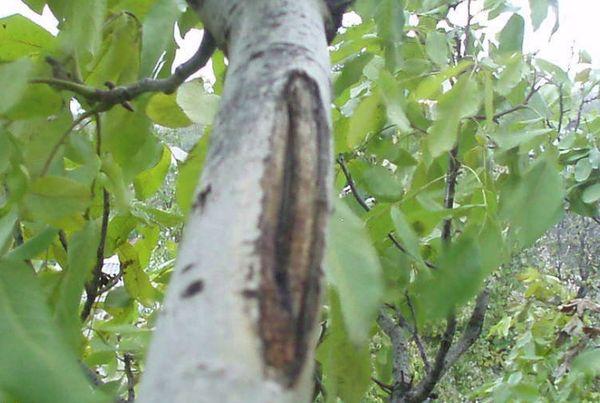
The second treatment should be carried out if the spots on the leaves have increased in size. The crown is sprayed twice more every 2 weeks.
It is useful to process trees before inflorescence appears. After harvesting, you can spray with preparations such as "Tsineb" or "Hom".
Disease control techniques include:
- pruning of damaged shoots, leaves;
- destruction of fruits if they have become brown and shriveled;
- carrying out activities until the plant is completely cured;
- burning all plant residues in autumn;
- digging soil in the garden in spring and autumn.
To protect against pests, both insecticidal preparations and traps are used. The number of moths in the garden is determined by how many individuals fall into the traps. Pheromone types of traps and food traps are used.
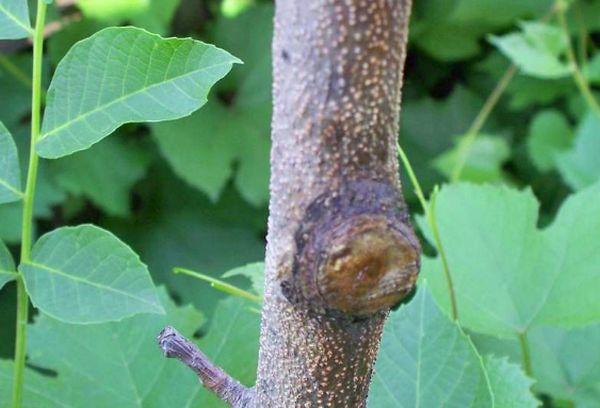
Sweet juice of fruits, berries, slightly fermented, is suitable as bait. They are trapped in the treetops. If there are a lot of butterflies, then it is necessary to treat the trees with pesticides. Poisons are used before the caterpillars appeared. Then it will be more difficult to cope with the pest, its offspring.
Before winter, they carefully examine the bark of trees, covering up damage and cracks with garden pitch. It is necessary to destroy the pupae and caterpillars lurking under the bark. The bark of walnut trees is cleaned where the sapwood beetles have laid their passages. It is imperative to remove mosses and lichens from walnut trunks.
Protection from pests consists not only in chemicals, but also in biological agents. Avermectin-based insecticides are safer. It is allowed to use agents of the thiacloprid group, chloranthraniliprols.
If you wet the branches well with insecticidal preparations during treatment, then the number of pests will decrease.
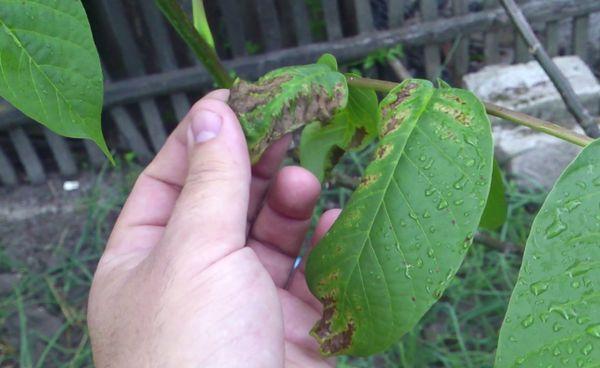
Preventive actions
It is possible to prevent diseases and pests on walnuts with a complex of agrotechnical, biological measures:
- Thinning the crown annually, removing diseased and damaged branches will increase the illumination of the tree.
- Several times during the growing season, they loosen the soil in the aisles, removing weeds.
- Examining a walnut for caterpillar and beetle nests will stop their reproduction.
- Timely feeding will help you grow healthy plants.
- As a prophylaxis, spraying with Bordeaux liquid is used three times, starting in early spring.
- In order for a tree to bear fruit well, it is necessary to treat it in time for fungal and bacterial infections.
You should not wait until the foliage of the walnut begins to turn yellow; you need to water and feed the plant on time. Be sure to make sure that there is no damage to the bark, shoots of the nut culture.
